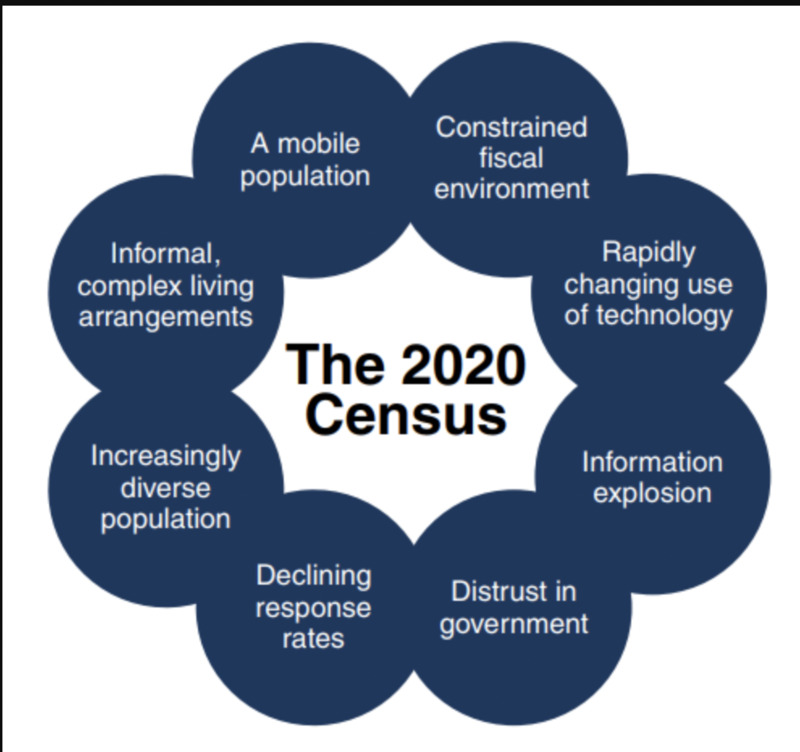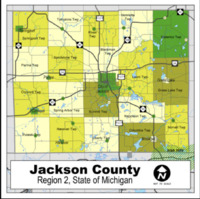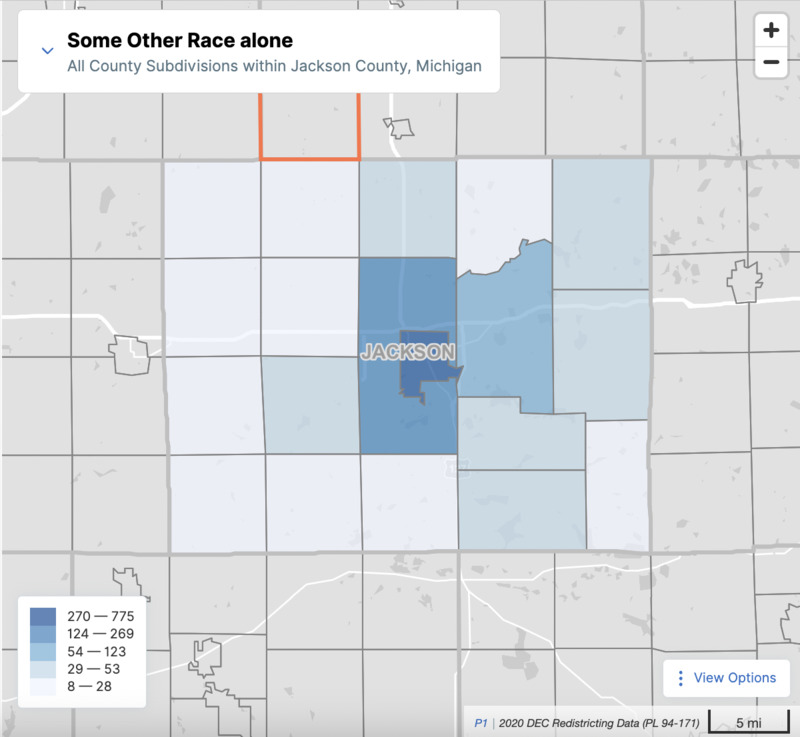Demographics
The United State Census Bureau provides periodic and comprehensive statistics about the nation through its compilation and publication of the Census every 10 years. The Census Bureau takes the survey against different demographic measures such as population, housing, age, race, ethnicity, and employment. Census data is used to tell us who we are as a nation and where we are going, helps communities determine where to build resources like schools, supermarkets, homes, and hospitals, as well as enable the federal government to decide how to distribute funding and assistance to states and localities. Census data is used for political apportionment in deciding the number of seats that each state and county receives in the U.S. House of Representatives as well as State legislatures based on population counts. Redistricting occurs after the results of each Census are released as electoral districts are adjusted based on where the population increased or decreased.
The Census Bureau’s goal is to “count everyone once, only once, and in the right place.” The Census Bureau sees this goal as being realized by counting people where they are at the moment that the survey is taken. This means that incarcerated persons are counted as residents of the jails and prisons in which they are confined in. We explore this issue on our prison gerrymandering page, but as we explore the demographics of Jackson County, Michigan, it is important to understand where this data is coming from and which populations it is based upon as such data leads to real shifts in political and economic power based in part on the inclusion of incarcerated persons in the Jackson prison facility into the Jackson County population.
According to the 2020 Census, Jackson County spans 701.7 square miles in land area, making it the 29th largest county in Michigan by total area. The total population, including up to 6,776 incarcerated individuals within the Jackson prison system, is 160,366 persons. That means that those incarcerated in any of the four facilities that make up the Jackson prison system account for 4% of Jackson County’s population. Although 4% may not seem like a dramatic figure, it is considering that these 6,776 individuals are counted as “residents” of Jackson County, rather than the counties across Michigan from which they come from. As our section on prison demographics demonstrates, the majority of these inmates are minority individuals from more urban centers and counties like Wayne County in which Detroit resides. By counting these individuals as part of Jackson County’s population rather than the counties that they actually reside in when not incarcerated, political power is shifting towards more rural and Republican-leaning Jackson County and away from urban and Democratic centers. This also impacts how resources and federal programs are allocated, as well as how seats in the House of Representatives are apportioned. The race-driven politics of mass incarceration and systemic over policing of minority neighborhoods increases the number of individuals of color who are incarcerated in rural counties, which then receive more political power, driving their advancement at the expense of the urban communities in which these inmates come from. We explore this issue further on our prison gerrymandering page.
The impact that the inclusion of incarcerated persons into the Census data counts for Jackson County is also reflective in race and ethnicity based demographics. According to the 2020 Census, there were 133,257 white people living in Jackson County. The largest minority population in Jackson was those who identified as Black, numbering 12,632. The second largest minority group was 6,184 individuals who identified as Hispanic or Latino, followed by those who identified as Asian at 1,493 persons. As our prison demographics (LINK) section makes clear, the vast majority of those incarcerated in the Jackson prison system identify as Black. The fact that those who identify as Black are so clearly the largest minority group begs the question of what impact that incarcerated Black men in Jackson prisons have towards the Census’ racial profile data. The inclusion of these incarcerated Black men into the general racial demographic data gives an unrealistic, and frankly incorrect, depiction of the racial makeup of Jackson County and the kind communities in which it supports.
The median household income in Jackson County as reported by the 2020 Census was $54,511. Jackson’s median income falls slightly below the median household income of Michigan which was $59,234. The poverty level in Jackson County of 12.4% actually falls below that of Michigan as a whole which measures 13.7%. But compared to the 2021 Federal Poverty Guidelines, the median household incomes of Jackson County and Michigan as a whole far surpasses that of the Federal Poverty Level. Interestingly, the higher median household income in Jackson County is not due to widespread attainment of secondary education, which falls at 22.5% of the Jackson population, lower than the 30% of the population of Michigan as a whole. Despite the lower rate of secondary educational attainment, the employment rate in Jackson County rests at 53.8%. This is largely due to the fact that the largest industry for civilian employed populations in Jackson County is manufacturing, retail trade, educational services, health care, and social assistance, as well as public administration which includes working within the Jackson prison system.
Michigan’s Department of Corrections is the third largest employer in Jackson County, providing jobs for over 2,000 employees. In order to become a correctional officer, the only requirements are being 18 years old and having a High School diploma or GED. Therefore, the lower percentage of the Jackson County population having a Bachelor’s degree is not relevant as the Jackson prison system, which does not require secondary education, is such a large employer. Without the massive prison system, the unemployment rate in Jackson County would indefinitely increase as one of the largest industries would be gone. The county has become dependent on the prison system, fed by mass incarceration and the hyper-criminalization of minorities, making the prison system more and more fully entrenched into Jackson society.
The political climate of Jackson also contributes to the proliferation of its prison-industrial complex. Classified as moderately conservative, 58.5% of voters, which excludes inmates who lack the right to vote, chose the Republican candidate Donald Trump while only 39.5% voted for Joe Biden in the 2020 Presidential Election. Jackson County as a whole voted Republican in five out of six of the last Presidential elections, excluding the year 2008. Although being Republican does not necessarily indicate support for high incarceration, the reality is that the Republican party’s national platform rests on a tough-on-crime stance that emphasizes the “effectiveness” of the hyper criminalization of minority communities who are deemed dangerous. The Republican Party in general does not recognize the need to address mass incarceration, nor the real racial and socioeconomic routes of over-policing that directly feeds into the cycle of mass-incarceration that allows cities like Jackson to sustain themselves through their prison systems.
In the last four years, Jackson residents have made 2,804 contributions totaling $176,993 to the Democratic Party and liberal campaigns while other Jackson residents have made 950 contributions totaling $344,810 to the Republican Party and conservative campaigns. This indicates that the wealthiest individuals in Jackson County, the same kinds of wealthy business people who benefit from the prison industrial complex in Jackson, are disproportionately donating to Republican campaigns and candidates who share their same ideals surrounding crime and mass incarceration.
The current House of Representatives congressman representing south-central Michigan, the district that includes Jackson, is Tim Walberg. Walberg was formerly a pastor in Michigan and Indiana before serving in the Michigan House of Representatives. He is a “defender of traditional values” and a “principled legislator.” Walberg is indicative of the kind of idealism behind the conservative-Christian majority in Jackson which guides the city politically, economically, and socially.
Sources:
"Committment to America - About Tim." Congressman Tim Walberg, Representing the 7th District of Michigan. https://walberg.house.gov/.
"Economic and Workforce Development - Jackson County Strategic Plan." County of Jackson, Michigan. Published in 2020. https://www.co.jackson.mi.us/DocumentCenter/View/1339/Issue-Analysis-PDF.
Fisher, Garrett et. al. "Prison Gerrymandering Undermines our Democracy." Brennan Center for Justice. Published October 22, 2021. https://www.brennancenter.org/our-work/research-reports/prison-gerrymandering-undermines-our-democracy.
"Jackson County, Michigan." United States Census Bureau. Published in 2020. https://data.census.gov/profile?g=0500000US26075.
"Jackson, Michigan." Bestplaces. https://www.bestplaces.net/voting/city/michigan/jackson.
"Jackson County." Region 2 Planning Commission. Published in 2022. http://www.region2planning.com/jackson-county/.
"Minimum Qualifications." Michigan Department of Corrections. https://www.michigan.gov/corrections/careers/minimum-qualifications.
"Our Censuses." United States Census Bureau. https://www.census.gov/programs-surveys/censuses.html#:~:text=The%20census%20tells%20us%20who,assistance%20to%20states%20and%20localities.
Jarmin, Dr. Ron. "Redistricting Data: What to Expect and When." United States Census Bureau. Published July 28, 2021. https://www.census.gov/newsroom/blogs/director/2021/07/redistricting-data.html.
Jarosz, Beth et. al. "U.S. 2020 Census FAQ." Population Reference Bureau. Published May 7, 2019. https://www.prb.org/resources/u-s-2020-census-faq/#:~:text=The%20Census%20Bureau's%20goal%20is,once%20and%20miss%20others%20entirely.
Mather, Mark et. al. "Why Is the U.S. Census So Important?" Population Reference Bureau. Published March 15, 2019. https://www.prb.org/resources/importance-of-u-s-census/.
Woodie, Alex. "The Big Data Tech Inside the 2020 Census." Datanami. Published January 9, 2018. https://www.datanami.com/2018/01/09/big-data-tech-inside-2020-census/.
"2021 Poverty Guidelines." Office of the Assistant Secretayr for Planning and Evaluation, U.S. Department of Health and Human Services. Published in 2021. https://aspe.hhs.gov/topics/poverty-economic-mobility/poverty-guidelines/prior-hhs-poverty-guidelines-federal-register-references/2021-poverty-guidelines
No item selected



